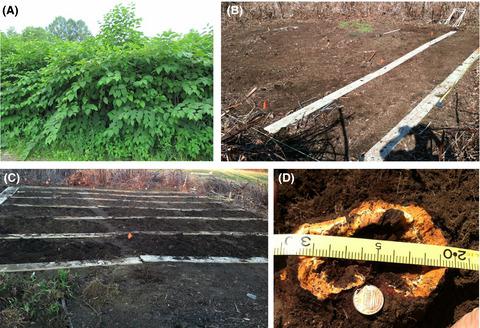当前位置:
X-MOL 学术
›
J. Appl. Ecol.
›
论文详情
Our official English website, www.x-mol.net, welcomes your
feedback! (Note: you will need to create a separate account there.)
Effect of soil carbon amendments in reversing the legacy effect of plant invasion
Journal of Applied Ecology ( IF 5.0 ) Pub Date : 2020-09-09 , DOI: 10.1111/1365-2664.13757 Ziliang Zhang 1 , Prasanta C. Bhowmik 2 , Vidya Suseela 1
中文翻译:

土壤碳改良剂在逆转植物入侵的遗留效应中的作用
更新日期:2020-09-09
Journal of Applied Ecology ( IF 5.0 ) Pub Date : 2020-09-09 , DOI: 10.1111/1365-2664.13757 Ziliang Zhang 1 , Prasanta C. Bhowmik 2 , Vidya Suseela 1
Affiliation

|
- Invasive plants are key drivers of global environmental changes leading to the disruption of ecosystems. Many invasive species engage in novel niche construction through plant–soil feedbacks that are driven by plant secondary compounds. These compounds can persist in the soil even after removing the invader, thus creating a legacy effect that inhibits the return of native flora and fauna. The formulation of active intervention strategies that can reverse niche construction is therefore critical for the restoration of these invaded ecosystems.
- We conducted this study in an old‐field in Massachusetts, USA, that has been invaded by Japanese knotweed (Polygonum cuspidatum) for >20 years. We chose knotweed as a model system as it alters soil chemistry and microbial community through the input of polyphenols such as tannins that creates a legacy effect. Following the removal of knotweed biomass, we investigated the effect of two soil carbon (C) amendments (biochar and activated carbon) on the growth and establishment of newly seeded native and prairie species. We measured the percent plant cover and above‐ground biomass to assess the establishment of the native and prairie species. We also measured soil and microbial characteristics including nutrient availability, extracellular enzyme activities and fungal biomass to elucidate the effect of C amendments in reversing the legacy effect.
- Eventhough the native species did not respond positively to C amendments, the biomass of the prairie species was 80% higher in activated carbon and biochar amended plots than the non‐amended control plots. The nitrate content of the C amended plots was five times higher than the non‐amended plots indicating an increased N mineralisation in the C amended plots. This could be potentially due to the amelioration of phenolic compounds by activated carbon and biocharthrough sorption. The phenol peroxidase activity also increased in the activated carbon and biochar amended plots potentially due to the less inhibition by phenolic compounds. With the decrease in polyphenols, the fungal biomass decreased in C amended plots that may have resulted in faster nutrient cycling and increased availability of soil N.
- Synthesis and applications. The phenolic compounds from the litter of invasive species that persist in soil C fractions can negatively affect the germination and growth of the native or non‐invasive plant species. The polyphenols such as tannins from the litter can complex nitrogenous compounds in soils making the N unavailable to the native or non‐invasive species. Our results revealed the potential of soil C amendments in reversing niche construction and legacy effects of polyphenol‐rich invasive species and indicated that biochar could be a more economically feasible alternative to activated carbon in restoring invaded ecosystems. These results also emphasise thatunderstanding the mechanisms through which invasive species create a legacy effect is pivotal in formulating suitable knowledge‐based practices for restoring invaded ecosystems.
中文翻译:

土壤碳改良剂在逆转植物入侵的遗留效应中的作用
- 外来入侵植物是导致环境破坏的全球环境变化的主要驱动力。许多入侵物种通过植物次生化合物驱动的植物-土壤反馈参与了新颖的生态位构建。这些化合物甚至在清除入侵者后仍会保留在土壤中,从而产生了抑制原生动植物返回的遗留效应。因此,制定能够逆转生态位建设的积极干预策略对于恢复这些入侵的生态系统至关重要。
- 我们在美国马萨诸塞州的一个旧田野中进行了这项研究,该田野受到日本虎杖(Polygonum cuspidatum)的侵袭。)> 20年。我们选择虎杖作为模型系统,因为它通过输入多酚(例如单宁酸)改变了土壤化学和微生物群落,从而产生了遗留效应。去除虎杖生物质后,我们调查了两种土壤碳(C)改良剂(生物炭和活性炭)对新播种的本地和草原物种生长和建立的影响。我们测量了植物覆盖率和地上生物量的百分比,以评估本地和草原物种的建立。我们还测量了土壤和微生物特征,包括养分的利用率,细胞外酶活性和真菌生物量,以阐明C修正剂在逆转遗留效应方面的作用。
- 尽管本地物种对碳修正没有积极反应,但在活性炭和生物炭修正地块中,草原物种的生物量比未修正的对照地块高80%。碳改良区的硝酸盐含量是非修正区的五倍,这表明碳改良区的氮矿化增加。这可能是由于活性炭和生物炭吸附作用改善了酚类化合物。苯酚过氧化物酶的活性在活性炭和生物炭修正区中也有所增加,这可能是由于酚类化合物的抑制作用较小。随着多酚的减少,在经过修正的C地块中真菌生物量减少了,这可能导致了更快的养分循环并增加了土壤N的利用率。
- 综合与应用。入侵物种凋落物中的酚类化合物残留在土壤C馏分中可能会对天然或非入侵植物物种的发芽和生长产生负面影响。凋落物中的单宁等多酚可以使土壤中的含氮化合物络合,从而使天然或非侵入性物种无法获得氮。我们的研究结果揭示了土壤碳改良剂在改变生态位建设和多酚丰富的入侵物种的遗留效应方面的潜力,并表明生物炭在恢复被入侵的生态系统方面可能是活性炭更经济可行的替代品。这些结果还强调,了解入侵物种创造遗产效应的机制对于制定适当的基于知识的实践来恢复入侵的生态系统至关重要。











































 京公网安备 11010802027423号
京公网安备 11010802027423号